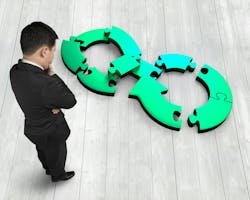Reduce, reuse, recycle: that’s the mantra millions of schoolchildren have been taught for decades as a way to remember to take care of the planet. But what about reuse, repair, remanufacture?
A circular economy, in simple terms, is a closed-loop system where materials and resources are reused for different applications. Magdi Azer of the Remade Institute, which specializes in advancing projects that promote circularity, spoke about how a circular economy is best achieved in today’s world, the obstacles to adoption and the work his organization does.
Q: What does the process look like in order to achieve a circular economy?
A: It’s all that material being taken out of the ground or made that drives economic growth. In a circular economy, you’re trying to decouple economic growth from material consumption. So you do that by finding ways to decouple the use of resources; that might be metals, it might be fossil fuels, it might be biomass, the things like feedstocks, the crops that you grow. So you have to decouple the use of materials from the economic growth but you also have to decouple the environmental impact from economic growth, which is a big challenge.
There was a report that came out from the International Resource Panel, a unit within the United Nations Environmental Program (UNEP), called Global Resources Outlook 2024 where they look at how much material we’re consuming today and the projections for the future.
We, as the world, have tripled the amount of resources that we use compared to 50 years ago, and of course a lot of that is going towards helping the developing world grow. But equally problematic is between now and 2060, that consumption is going to grow another 60 percent.
There’s a term referred to as Earth Overshoot Day, the day and the year when we have used up as many resources as we can regenerate and repopulate, things like crops or fossil fuels. So right now, we’re using a little under twice the amount of resources, globally, that we can replenish. We’re kind of on a path to using things up which, again, if you stay with a linear economy, that means economic growth has to somehow slow if you can’t get access to the materials you need to build buildings or feed people.
Q: Is it realistic to think the world would be willing to shift to a whole new economic framework?
A: The concept of a circular economy is somewhat new. People talk a lot about sustainability, and that has different meanings for different people. A lot of them think about sustainability in terms of recycling, but it’s broader than that. The big challenge you face is the same challenge you face in addressing the climate crisis, which is that the Western world has become much more efficient in our use of resources, but the developing world isn’t. They’re saying, basically, “Why should our economic growth and development be hindered when for the last 150, 200 years since the dawn of the Industrial Revolution, you guys in the Western world have had no problem consuming resources?”
I think within industry the term “circular economy” is gaining traction. Again, it’s not always clear that people understand what that means, but they certainly understand the concept that we can’t keep using resources that we can’t replenish.
Q: How would the timeline look, in regard to not only the shift, but also to implement it and for us to start seeing the results?
A: In a discussion of greenhouse gas emissions, people are talking about “What can we do by 2030 or 2035, and certainly by 2050?” Maybe to give you a different spin on it: When we talk about climate change, there’s a big push toward “We need to go to renewables, we need to go to solar, we need to go to wind,” instead of burning fossil fuels to generate electricity and energy. But the Ellen MacArthur Institute, which focuses on the circular economy and getting that message out, released an analysis in 2019 that said even if you were to implement greater levels of solar and wind, that only gets you 55 percent of the way to net-zero emissions.
The rest of that emissions has to come from the way we produce things. That other 45 percent will only come as we focus on how we consume the materials we use. Five materials — steel, aluminum, cement, food supply and plastics — account for roughly half of that 45 percent, so there is a lot of work trying to reduce the use of those resources or move to processes that generate less greenhouse gas emissions when you produce them, and that’s called industrial decarbonization.
Q: What does research at the Remade Institute look like?
A: We’ve got roughly 165 to 170 members from industry academia, like the National Labs and Trade Association. As an institute, we will release a request for proposals. Maybe we’re looking for proposals that allow us to recycle more aluminum because the energy it takes to recycle aluminum is 20 times less than the amount of energy it takes to produce the alloys in the first place, so there’s a huge benefit there. And then these combinations of industry, national labs and academia and trade associations will form teams and write proposals that address these topics.
One of the things that makes us different than, say, a university or national lab doing research is we are, first of all, a public-private partnership, which means government is involved but also companies are involved. It’s the companies that are defining the problem from an industrial perspective, not some professor in the lab who says, “I think I could do this and wouldn’t it be neat?” It’s the company saying, “I need to find a better way to recycle aluminum.”
About the Author
Jennifer Ramsay
Editor-at-Large, Endeavor Business Media
Editor-At-Large Jennifer Ramsay is in charge of multiple of Endeavor Business Media’s Market Moves newsletters. She also reports on the latest in the electric vehicle and clean energy spaces for IndustryWeek, FleetOwner, and EnergyTech. She has experience in various facets of multimedia journalism.

